#organic cotton textiles
Text
#online fabrics#online fabric shopping#online fabric material#fabric by the yard#organic cotton material#organic cotton textiles#best cotton fabric in india#annatto powder#organic corduroy fabric#hemp textiles#organic fabric material#bamboo fabrics#khadi silk material#bamboo fibre fabric#khadi silk fabric#khadi cotton fabric#muga silk#khadi silk cloth#swatch book#silk khadi fabric#silk muga#khadi fabrics#corduroy fabric#fabrics wool#ahimsa silk#white fabrics#is silk vegan#dyeing sarees#tussar silk saree plain#corduroy material
0 notes
Text
Yarn Dyed Fabrics
Yarn Dyed Fabrics: Where Artistry Meets Textile Innovation
Yarn dyed fabrics are a testament to the artistry and craftsmanship that elevate textiles to a whole new level. Unlike printed fabrics, where the design sits on the surface, yarn dyed fabrics are woven with threads pre-dyed in distinct colors, creating patterns and designs that run through the entire fabric. This results in a depth and richness of color that remains vibrant over time, making every garment or home textile a work of enduring beauty.
The meticulous process of yarn dyeing ensures that each thread is saturated with pigment before weaving, offering a longevity of color that resists fading. Whether it's classic stripes, intricate plaids, or intricate checks, yarn dyed fabrics bring a timeless and elegant aesthetic to your fashion or home decor. They are the preferred choice for those who seek quality and style that goes beyond the surface.
Choose yarn dyed fabrics for a touch of sophistication and textile excellence, where every thread tells a story of dedication to quality and design.
#organic cotton material#organic cotton textiles#best cotton fabric in india#annatto powder#organic corduroy fabric#hemp textiles#organic fabric material#bamboo fabrics#khadi silk material#bamboo fibre fabric#khadi silk fabric#khadi cotton fabric#muga silk#khadi silk cloth#swatch book#silk khadi fabric#silk muga#khadi fabrics#corduroy fabric#fabrics wool#ahimsa silk#white fabrics#is silk vegan#dyeing sarees#tussar silk saree plain#corduroy material#khadi fabric#khadi cloth material#ahimsa silks#linen fabric online
0 notes
Text
i would like everyone to know that i cited bill nye the science guy in my research paper and my research advisor did not bat an eyelash
#mostly bc nobody knows who the fuck he is in the philippines#i mentioned him again during my final defense this afternoon#it’s about using organic textiles as alternatives to synthetic cotton in face mask production#then i realized the absurdity of me explaining how he contributed to the rrl to the panel via MS TEAMS
31 notes
·
View notes
Text
#sri shakthi tex#fabrics#cotton bedspreads india#fabric manufacturers in erode#handloom textiles india#organic cotton textiles india#srishakthitex#fabric collection erode#handloommagic#textile manufacturers india
0 notes
Text
Don't be fooled while choosing Organic Clothing
In recent years, the demand for organic cotton clothing has soared as individuals become more conscious of the harmful chemicals used in conventional textile processes. However, unscrupulous individuals are looking to profit from this trend by misrepresenting their products.
This article aims to shed light on common practices used to deceive consumers and offers tips to help you identify genuine…

View On WordPress
#Apparel#Beauty#Clothing#Ecological Clothing#Fashion#Garment#Organic#Organic Cotton#Organic Cotton Clothing#Organic Fabric#T-shirt#Textile#Trendy#Tshirt
0 notes
Text

Discover the Comfort and Sustainability of M&S Textiles Australia's Organic Cotton
Are you tired of itchy and uncomfortable clothes? Switch to M&S Textiles Australia's organic cotton and discover a new level of comfort and sustainability. Our organic cotton is grown without the use of harmful pesticides and chemical fertilizers, ensuring that you wear only the safest and softest fabric possible. What's more, M&S Textiles Australia sources its organic cotton from fair-trade farmers, ensuring that they are paid fairly for their products and that their families and communities benefit from our purchases. Not only will you feel great in our organic cotton, but you'll also be supporting ethical and sustainable practices in the fashion industry. So why wait? Make the switch now by buying our products online through https://www.mstexaustralia.com/ and start enjoying fashion that is both comfortable and responsible.
0 notes
Text
Exploring the World of Open End Yarn: Gupta Fibres at Your Service
In the textile industry, yarn is the foundation of every fabric. It's the thread that weaves dreams into reality. When it comes to open-end yarn, one name stands out - Gupta Fibres.
Gupta Fibres, a pioneering name in the textile world, is renowned for its exceptional open-end yarn manufacturing services. With a strong commitment to quality, innovation, and sustainability, they have earned their place as leaders in the industry.
Quality Assured
At Gupta Fibres, quality is paramount. Their open-end yarn is known for its consistent quality and performance. Whether it's for knitting, weaving, or other applications, Gupta Fibres' open-end yarn is trusted by textile professionals across the globe.
Diverse Range
Versatility is a hallmark of Gupta Fibres' open-end yarn services. They offer an extensive range of options to cater to various textile needs. From cotton to polyester, Gupta Fibres provides yarns that suit different materials, styles, and purposes.
Innovation and Sustainability
Gupta Fibres has not only kept pace with changing times but also embraced them. Their commitment to sustainability shines through in their innovative approaches to open-end yarn manufacturing. They utilize eco-friendly processes and materials to minimize their environmental impact.
Customer-Centric Approach
What sets Gupta Fibres apart is their unwavering dedication to their customers. They understand the unique needs of each client and offer tailored solutions. This customer-centric approach has solidified their reputation as a reliable partner in the textile industry.
Conclusion
In the world of open-end yarn, Gupta Fibres is a name synonymous with quality, diversity, sustainability, and customer satisfaction. As open-end yarn manufacturers, they have continually set new standards for excellence. With Gupta Fibres at your service, you can be confident that your textile creations are in the hands of experts who are passionate about their craft.
#fiber weaving products#cotton fiber yarn#Organic Cotton Yarn Wholesale#Polyester Yarn Suppliers in India#Cotton Yarn Manufacturers in Panipat#Cotton Yarn Suppliers in India#Yarn Exporters in India#Yarn Dyed Fabric Manufacturers#Textile Yarn Manufacturers#Open End Yarn Manufacturers#Cotton Yarn Manufacturers in India
0 notes
Text
Exploring the Advancements in Textile Manufacturing: How Companies are Innovating the Industry
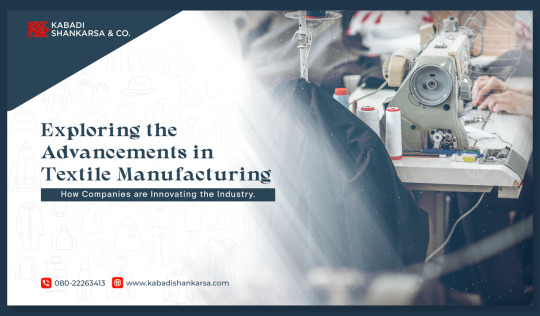
The textile industry is constantly evolving and advancing, and textile manufacturing companies are at the forefront of these changes. One area in which we are seeing significant innovation is in the production of woven fabrics. Woven fabrics, which are made by interlacing two sets of yarns or threads at right angles to each other, are used in a wide variety of products, including clothing, home furnishings, and industrial products.
One of the most exciting developments in the world of woven fabrics is the use of new and advanced weaving technologies. These technologies allow manufacturers to create fabrics with unprecedented levels of precision and control, resulting in fabrics that are stronger, more durable, and more consistent in quality.
One example of these new technologies is the use of computer-controlled looms. These looms, which are operated by computers, can be programmed to create a wide variety of patterns and designs, allowing manufacturers to produce fabrics that are truly unique and customized to their customers' needs. This technology also enables textile manufacturing companies to produce fabrics at a much faster rate, increasing productivity and efficiency.
Another area in which textile manufacturing companies are innovating is in the use of sustainable and eco-friendly materials. Many companies are now using natural fibers like cotton and linen, as well as synthetic fibers made from recycled materials, in their woven fabrics. This not only helps to reduce waste and conserve resources, but it also allows manufacturers to create fabrics that are kinder to the environment.
Finally, textile manufacturing companies are also exploring new ways to use technology to improve the overall supply chain of textile manufacturing. The use of automation in textile manufacturing process has enabled companies to increase efficiency, improve quality control and reduce costs.
In conclusion, the textile industry is constantly evolving and textile manufacturing companies are at the forefront of these changes. From new weaving technologies to sustainable materials, textile manufacturers are finding new and exciting ways to innovate and improve the products they produce. This is an exciting time for the textile industry, and we can expect to see even more advancements in the future.
Kabadi Shankarsa is one of the leading textile manufacturers in India. Upgrade your textile production with our state-of-the-art manufacturing equipment. Our machines are designed to increase efficiency and reduce waste, resulting in cost savings for your business.
Don't miss out on this opportunity to take your textile manufacturing to the next level. Contact us today to schedule a consultation and see how we can improve your bottom line.
#fabric manufacturers#textile manufacturing companies#embroidered fashion fabrics#textile manufacturers#silk scarves for women#non woven fabric manufacturer#woven cotton fabric#sustainable fabric suppliers#woven geotextile fabric#automotive fabric suppliers#polyester woven fabric#organic fabric suppliers
1 note
·
View note
Text
fiber art adventures in egypt
I recently got back from a trip to Egypt & finally got around to organizing some pictures to share. One of the things I was most excited about was seeing what I could find on fiber arts and textiles.
Dropping everything under a read more, 'cause this will be a long post haha
first visit: the National Museum of Egyptian Civilization (NMEC)
At the time of visiting, they had a special textiles exhibit. It covered Pharonic Egypt all the way up to modern times, although I only had time to check out the dynastic & a bit of the Coptic portion of the exhibit (which was what I was really hoping to see anyways)
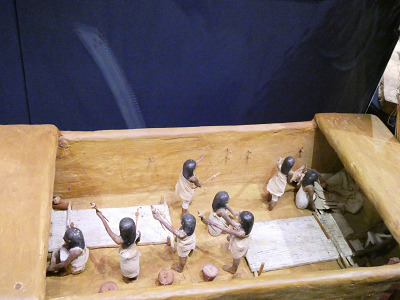

Was super excited to see this diorama in person. I knew about it but had never seen good pictures of it. From the little I've seen of ancient Egyptian spinning, spinning with two spindles seems to be the norm rather than a master technique? It also shows up in tomb art, which the exhibit also shared:

They also used a different fiber preparation (splicing to create a rove of fiber, no traditional drafting to my understanding) so that probably made a difference? Regardless I really want to see if I can replicate the technique, especially because their spindles look so similar to modern spindles??

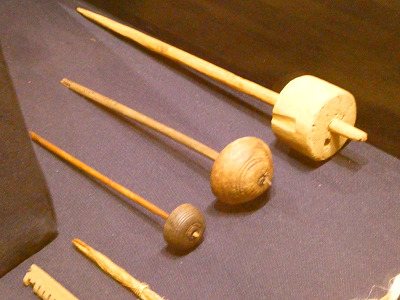
I took so many pictures of spindles, guys, and I fully intend to either have a few replicas made or to learn to make some myself. Also, although they were unlabeled... I'm pretty sure those are beaters for weaving? That was a bit of a trend with this trip, so much stuff was unlabeled :( I would've killed to at least get some date estimates for some of the stuff they had on display. I was nerding out in here though, and my family took a few pictures of how excited I was getting. A bit embarrassing, but eh haha
The exhibit also had a section on natural dyes used with a fun visual;
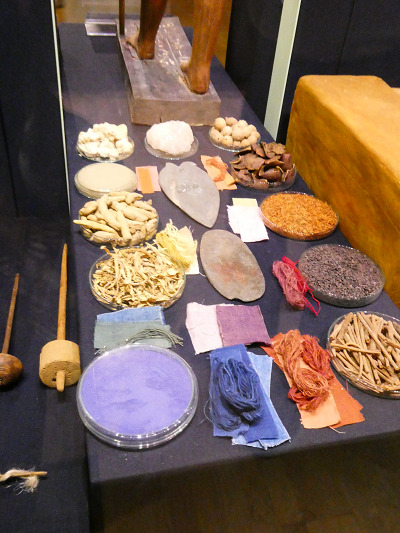
There was several diagrams specifically describing each dye source, but in the interest of not overloading on pictures I'll just list them out. For blues; woad, Yellows; turmeric, safflower, saffron, or yellow ochre; reds; madder, henna, pomegranate, and kermes. I originally thought kermes was another way to say cochineal, but it only seems to be distantly related.
next visit: Ramses Wissa Wassef Art Center
A small art center dedicated to hand-weaving wool and cotton tapestries. All of their work was museum quality & awe inspiring!!
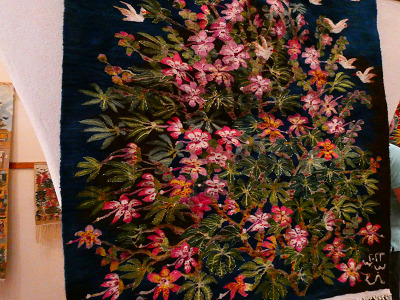


Was even invited to their back rooms to watch a few of their weavers working; no I don't have room to put a room-sized loom anywhere but heck do I want one now

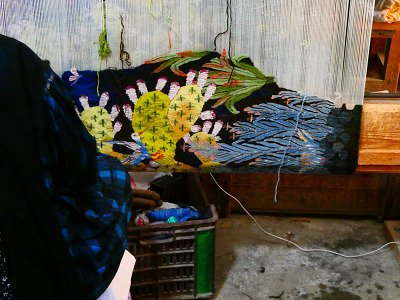
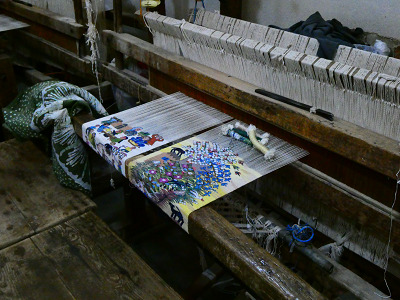
Our guide that took us through talked a bit about the natural dyes they use (all of their dyes are dyed in house with what they grow in their dye garden!!!) and got excited to hear I was also interested in natural dyes! He seemed a bit disappointed I'd never worked with indigo and. while indigo scares me, I'll take it as a sign that maybe I should try some time this year haha.
final visit; the Egyptian Museum
we really had to rush through this one which was a huge shame because it's packed full of artifacts. Also, the lighting in there is atrocious, so apologies for the not great pictures ahead.
They had a fascinating display of textile tools, more than what the NMEC had;



(Hand for size reference) I want all of these spindles! So badly! But a few of them look so much like a few of the spindles I own already?? A few of them had a spiraling notch, that's so cool? But also, what's going on with the one with two whorls? I have no idea. I'm fascinated.
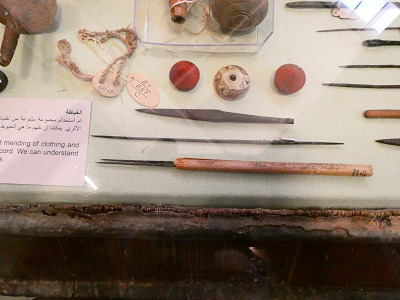

Look at these whorls!! Although again, I'm a bit confused; the lack of labeling strikes again. Unsure why some of these "whorls" have two holes, or what the metal object with the wooden handle is. The display implies sewing needles, and some of them do look like it, but others.... really don't look like sewing needles. I'm absolutely enchanted by this little whorl though. I think it has birds on it?
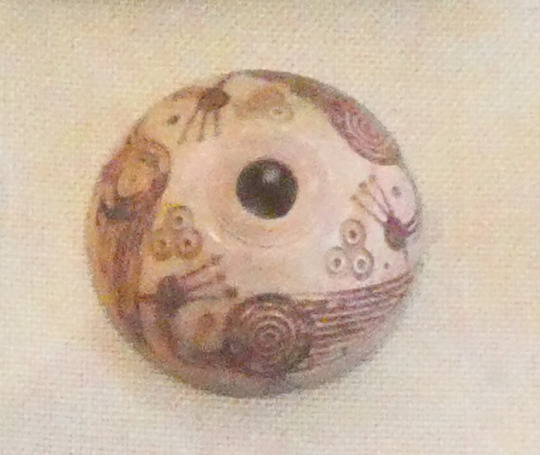

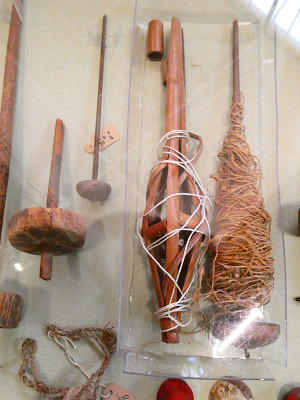
More objects that I'm baffled by- the signage doesn't really indicate what some of this stuff is, if it's even known. Also confused by the object wrapped in white string in the right pic; it looks like a distaff but to the best of my knowledge the (ancient at least) Egyptians didn't use distaffs. It probably popped up in later times and was put in this display since it was still relevant, but I'm still not sure.
I have so many more pictures & thoughts but I'll save those for more specific future projects. I've been doing research outside this trip on ancient Egyptian spinning techniques and desperately want to go deeper into that, this trip just solidified how excited it makes me. If you made it all the way through this, many thanks for reading!
Bonus; look at this ancient linen 🥺

#hand spinning#archaeology#extant artifact#weaving#fiber arts#long post#letters from skylark#sorry for the overall low quality images in this post. Got a new camera and wasn't the best at using it this trip#also the raw image files were huge so I heavily downsized them to make sure this post wasn't a beast to load#would be happy to share the raw images if desired though
256 notes
·
View notes
Text

Graptolite, 2023, hand dyed cotton fabrics using glue resist and textile decolorant, cotton thread and dowel rod
continuing my fascination with fossils and removal and their relationship to textile processes involving bleach. Freehand designs in glue follow a simple pattern built around drawn shapes, then are bleached with my iron. the process melts the glue while bleaching, leaving the designs vulnerable to marring and different than what they began as. interested in thinking about the ways fossilization and the ultimate removal and cleaning of these fossils by humans shapes our understandings of these organisms.
81 notes
·
View notes
Text
#silk fabrics#organic fabric#organic fabrics#ahimsa silk#cotton knit fabric#cotton fabric#painted fabric#muga silk saree#clothe store#fabric linen#organic corduroy fabric#natural dyed fabric#organic cotton fabrics#hemp cotton#muga silk fabric#muga fabric#silk khadi fabric#organic cotton fabric#banana fabric#hemp textiles#dyed fabrics#aloe vera fabric#hemp fabric#hemp fabrics#muga silk price#natural dyed#lotus fabrics#fabric hemp#hemp fabric textiles#handloom khadi fabric
0 notes
Text
online fabric shopping
#online fabric shopping#fabric shopping#linen fabric online#online shopping#fabric online#kala cotton fabric online#cottony fabric#khadi silk fabric#hemp textiles#organic corduroy fabric#organic fabrics#online fabrics#sustainable fabric supplier#top 10 online fabrics#buy fabric online#fabric shopping online#fabric by the yard#fabric linen#linen fabric#alum powder#silk khadi fabric#silk saree#online fabric store#buy fabric
0 notes
Text
i've NEVER seen a single good faith discussions about pleather on this website and i want ppl to think critically for one second about the way businesses talk about their products. "vegan leather" is purely a marketing term and nothing else. it was invented by the fashion industry and it has nothing to do with vegans or veganism.
"vegan leather" is basically made of polyester (a type of plastic), but crucially a lot of clothes nowadays are made of polyester either fully or partially because it's cheaper to produce. so of course clothing companies are going to be producing and marketing things that make them more money.
these products are not even targeting vegans, they're making an average customer feel better about their purchases, same way they are now putting "eco" labels on some of their organic cotton clothing. it's just greenwashing. NOTHING in fast fashion is eco friendly in any way - this whole industry is extremely wasteful an exploitative on every level. when are ppl going to realize that these companies just say anything they can to make it seem like they care about anything other than their profit margins. because they don't.
my wish is that ppl that talk about how bad pleather is and how vegans are apparently responsible for all of the microplastic pollution in the world also talked or cared even a little bit about the absolutely horrific abuse and exploitation that happens in the clothing and fast fashion industry. talk about how this industry consistently fails (or outright refuses) to pay its workers a living wage or how they don't provide them humane working conditions - and how that led to thousands of garment workers dying and getting injured when a garment factory collapsed in Bangladesh (and that's not the only tragedy this industry is directly responsible for).
also microplastics are only the tip of the iceberg if you want to talk about the pollution that the clothing industry is responsible for (toxic chemicals and pesticides used in cotton production, garment dyes, the disposal of textile waste etc) - all of which has direct human costs tied to it.
but if your only concern ever was microplastics that clothes can shed then great! avoid all polyester and plastic clothing. but did you know textiles aren't even the primary microplastic contaminants? it's plastic bags, bottles and fishing nets by far. most ppl can't always avoid these plastic items in daily life. but do you eat fish? vegans don't.
i'm just so tired of the pleather discussion focusing on the wrong thing (vegans) when there are so many more aspects about the clothing industry and plastic pollution that never get addressed when they should. and the amount of misinformation on these topics is just laughable at this point. ppl sure enjoy reblogging posts that confirm their biases and free them from having to critically engage with complicated issues because it's so easy to just blame a group of ppl for it.
anyway if you're concerned about ethical clothing (i hope you are) then basically these are your best options:
wear what you already have and don't buy new clothes unless necessary
get second hand clothes
get upcycled clothes
this may seem a bit extreme but these are the only options that don't result in new clothes and textiles being produced because there is an overproduction issue in the clothing industry which is why over 80% of clothes end up in landfills. obviously these options aren't viable for everyone all the time but if the goal is sustainability then that's just the reality of things for now.
you can also do things like mend your clothes so they last longer, learn to sew to make your own clothes etc all of that is better than buying new clothes. donating clothes to a thrift store is also not ideal since they get so many donations that a lot of it ends up in a landfill anyway and recycling clothes is also not straightforward or even possible in a lot of cases. so not buying new/more clothes is the most environmentally friendly option. and before you go no ethical consumption under capitalism blah blah yeah we know. doesn't mean you are powerless and have no choices in anything ever.
please learn more about microplastics, the clothing/textile industry and veganism before you uncritically reblog another misinformed post about "vegan leather" or microplastics. also please don't uncritically believe what i wrote here either. if you're seriously interested in these topics then your source for this information shouldn't be some tumblr post in the first place. there are lot of studies, documentaries and articles about all the things i mentioned. i'm not a researcher or a scientist, so don't ask me. i'm just tired.
#vegan leather#veganism#pleather#fast fashion#long post#not interested in discussion tbh#i'm just venting#do ppl that are obsessed with pleather even read clothing labels#do you know where your clothes were made#do you know who made them#and do you know how much they were paid for their labor?#why aren't you mad about that
224 notes
·
View notes
Text
#cotton bedspreads india#sri shakthi tex#fabrics#handloom textiles india#fabric manufacturers in erode#fabric collection erode#handloommagic#srishakthitex#textile manufacturers india#organic cotton textiles india
0 notes
Text
oh man. it's funny, i used to think that fashion was shallow and superficial and not worth thinking about. but i would get twisted into knots about it because of *course* i wanted to wear clothes that felt good and looked good, it just seemed like a "dumb" thing to be interested in.... i think it's partly internalized misogyny. well, anyway: i resell and trade clothes now, and this past week i've received a few effusive thank you notes from people who i mailed clothes to. like, it made their day, or it was something they were searching for for a long time. and when they put it on they felt transformed! i know that feeling. i am sitting at my computer in my 100% organic cotton black loungewear. and it feels so good. earlier this week i was walking around in my big bud press pants. my vintage sweater. my rainbow nooworks shirt. smiling, being happy.
being happy with how you look and feel! what a concept!
let's bask in mutual appreciation! ohmmmmmm
where was i going with this? well, i don't know. i think some people would like other people to think that fashion is shallow and superficial when it's actually something that goes back as far as human history... textiles... wearing textiles for comfort, practical purposes, self expression... and it can feel easy to feel defeated by modern fashion because of mass market consumerism fast fashion yadda yadda that's just throwing garbage in your face all the time. but if you can find something you enjoy, and other people enjoy it, and you're sharing this hobby. it's like a little handshake. same hat. same hat! literally.. same fucking hat. and that's beautiful
49 notes
·
View notes
Text
WASHINGTON, D.C. (KLTV/KTRE) - Congressman Nathaniel Moran (TX-01), member of the House Foreign Affairs Committee, celebrated the passage of his legislation, H.R. 4039, No Dollars to Uyghur Forced Labor Act, which prohibits funds to the Department of State or the United States Agency for International Development (USAID) to finance international projects in partnership with entities that import products mined, produced, or manufactured in the Xinjiang Uyghur Autonomous Region of the People’s Republic of China, commonly known for the genocide and forced labor of the Uyghur people.
On June 21, 2023, H.R. 4039 was marked up in the House Foreign Affairs Committee and was reported favorably out of the committee. This week, the No Dollars to Uyghur Forced Labor Actpassed the House of Representatives by a voice vote.
“The passage of No Dollars to Uyghur Forced Labor Act is an important step in showing the U.S. government’s commitment to confronting the abuses of the Chinese Communist Party. As a Chinese dissidents and human rights activist, I’ve experienced first-hand the extent that the Chinese government is willing to go to maintain power. After years of evidence and brave survivors speaking out, the world can no longer ignore the Uyghur genocide. It is imperative for our consciences to remove all U.S. funding from the Uyghur region. I am grateful for Representative Moran’s leadership on this resolution and the cosponsors who endorsed it,” said Dr. Rev. Bob Fu, Founder and President of ChinaAid.
“Uyghurs worldwide are thankful to Representative Moran and the U.S. Congress for passing a bill which ensures that our tax dollars do not fund ongoing atrocity crimes and modern-day slavery. This bill also sends a powerful message globally that the United States will continue to exercise all options to ensure that we end complicity in forced labor,” said Omer Kanat, Executive Director of the Uyghur Human Rights Project.
Background:
The Chinese Communist Party is committing genocide against the Uyghurs in the Xinjiang Uyghur Autonomous Region (XUAR) of China, repressing ethnic minorities for practicing their faith, detaining people in “reeducation centers” and ultimately using them for forced labor in the XUAR. This region of China is essential to their global supply chain, where many basic goods such as yarn, textiles, bricks, cotton, polysilicon, are produced using forced labor.
While the Uyghur Forced Labor Prevention Act prohibited goods made wholly or partly in the Xinjiang Uyghur Autonomous Region from entering U.S. supply chains, we must ensure that the United States is not developing international contracts for strategic projects with partners overseas that source goods or raw materials from the Xinjiang region.
H.R. 4039 will prohibit funds to the Department of State or the U.S. Agency for International Development (USAID) to finance global projects in partnership with companies or organizations that import products mined, produced, or manufactured wholly or partly from the Xinjiang Uyghur Autonomous Region of the People’s Republic of China.
12 notes
·
View notes